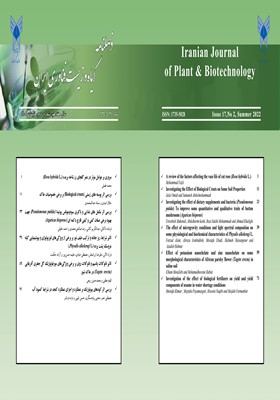مروری بر عوامل موثر در عمر گلجای رز شاخه بریده (Rosa hybrida L.)
محورهای موضوعی : گیاهان زینتی
1 - دانشجوی دکتری، گروه علوم و مهندسی باغبانی، دانشگاه تربیت مدرس، تهران، ایران
کلید واژه: نگهداری گل, عمر گلجای, گل شاخه بریده, فیزیولوژی پس از برداشت,
چکیده مقاله :
یکی از معیار های مهم در تعیین کیفیت گل شاخه بریده عمر گلجای آن است. عمر گلجای یک گل شاخه بریده به مدت زمان بین قرارگیری ساقه در محلول گلجای تا از دست دهی ارزش زینتی قابل رویت اشاره دارد. از علائم پایان عمر گلجای رز شاخه بریده میتوان به خمیدگی گردن، آبی شدن و پژمردگی اشاره نمود. عوامل بسیاری در عمر گلجای رز شاخه بریده موثر هستند که در دسته بندی کلی می توان آن ها را به دو دسته عوامل قبل از برداشت و عوامل پس از برداشت تقسیم بندی کرد. مهم ترین عوامل قبل از برداشت شامل رطوبت نسبی، آلودگی بوتریتیس، شرایط نوری، تغذیه و دما میباشد. مشاهده شده است که رز های پرورش یافته در رطوبت نسبی بالا، دوره نوری نور مداوم، شدت نور و CO2 کم و همچنین گل های پرورش یافته در فصل زمستان عمر گلجای کوتاه تری خواهند داشت. عموما تاثیر عوامل قبل از برداشت در عمر گلجای رز شاخه بریده بر روی تعادل آبی گیاه و عملکرد استوماتی آن است. زمان برداشت، طول ساقه ی گل، شرایط محیطی نگهداری گل و تاثیر برخی تنظیم کننده های رشد گیاهی از عوامل مهم پس از برداشت در گل شاخه بریده رز می باشند. در این مقاله مروری به بررسی این عوامل پرداخته خواهد شد.
1) Arve Louise, E., Meseret, T., Terfa, Hans Ragnar Gislerød, Jorunn E. Olsen, and Sissel Torre. 2013. High Relative Air Humidity and Continuous Light Reduce Stomata Functionality by Affecting the ABA Regulation in Rose Leaves. Plant, Cell and Environment, 36(2):382–92.
2) Bredmose, N. and N, Jørgen. 2004. Effects of Thermoperiodicity and Plant Population Density on Stem and Flower Elongation, Leaf Development, and Specific Fresh Weight in Single Stemmed Rose (Rosa Hybrida L.) Plants. Scientia Horticulturae, 100(1–4):169–82.
3) Capdeville, G., Luiz, A., Maffia, F., Finger, L. and G, Ulisses. 2005. Pre-Harvest Calcium Sulfate Applications Affect Vase Life and Severity of Gray Mold in Cut Roses. Scientia Horticulturae, 103(3):329–38.
4) Doorn, V. and G, Wouter. 2002. Effect of Ethylene on Flower Abscission: A Survey. Annals of Botany, 89(6):689–93.
5) Drüge, U. 2000. Influence of Pre-Harvest Nitrogen Supply on Post-Harvest Behaviour of Ornamentals: Importance of Carbohydrate Status, Photosynthesis and Plant Hormones. Gartenbauwissenschaft, 65(2):53–64.
6) Fanourakis, D. 2013. Sources of Vase Life Variation in Cut Roses: A Review. Postharvest Biology and Technology, 78:1–15.
7) Fanourakis, D., Susana, M., Carvalho, P., Domingos, P., Almeida, F. and Ep, Heuvelink. 2011. Avoiding High Relative Air Humidity during Critical Stages of Leaf Ontogeny Is Decisive for Stomatal Functioning, 274–86.
8) García Victoria, N. 2012. Effect of a diffuse glass greenhouse cover on Rose production and quality. Pp. 241–48 in Acta Horticulturae. International Society for Horticultural Science (ISHS), Leuven, Belgium.
9) Heo, J.W., Debasis, C. and P, Kee Yoeup. 2004. Longevity and Quality of Cut ‘Master’ Carnation and ‘Red Sandra’ Rose Flowers as Affected by Red Light. Plant Growth Regulation, 42(2):169–74.
10) In, B.Ch. and L, Jin Hee. 2017. Potential Vase Life of Cut Roses: Seasonal Variation and Relationships with Growth Conditions, Phenotypes and Gene Expressions. Postharvest Biology and Technology, 135(August 2017):93–103.
11) Khoshgoftarmanesh, A H., Khademi, H., Hosseini, F. and R, Aghajani. 2008. Influence of Additional Micronutrient Supply on Growth, Nutritional Status and Flower Quality of Three Rose Cultivars in a Soilless Culture. Journal of Plant Nutrition, 31(9):1543–54.
12) Kooten, O. and E, Kuiper. 2009. Consumer Acceptability in Flower Chains: How Can We Determine What the Final Customers Really Want, 17–26.
13) Ma, N. 2006. Transcriptional Regulation of Ethylene Receptor and CTR Genes Involved in Ethylene-Induced Flower
Opening in Cut Rose (Rosa Hybrida) Cv. Samantha. Journal of Experimental Botany, 57(11):2763–73.
14) Macnish, A., Ria, J., Leonard, T., Maria Borda, A. and A, Terril. Nell. 2010. “Genotypic Variation in the Postharvest Performance and Ethylene Sensitivity of Cut Rose Flowers.” HortScience : A Publication of the American Society for Horticultural Science, 45.
15) Van Meeteren, U. 2007. Why Do We Treat Flowers the Way We Do? A System Approach of the Cut Flower Postharvest Chain. Acta Horticulturae 755:61–73.
16) Mensink, Manon G. J. and Wouter G. Van Doorn. 2001. Small Hydrostatic Pressures Overcome the Occlusion by Air Emboli in Cut Rose Stems. Journal of Plant Physiology, 158(11):1495–98.
17) Mortensen, M. and G, Hans Ragnar. 2005. Effect of Air Humidity Variation on Powdery Mildew and Keeping Quality of Cut Roses. Scientia Horticulturae, 104(1):49–55.
18) Rasouli, O., Ahmadi, N., Behmanesh, M. and M. A, Daneshi Nergi. 2015. Effects of BA and TDZ on Postharvest Quality and Expression of Laccase and Aquaporin Genes in Cut Rose ‘Sparkle. South African Journal of Botany, 99:75–79.
19) Reid, M. S. 2009. Handling of Cut Flowers for Export. Proflora Bulletin, 1–62.
20) Torre, S. and T, Fjeld. 2001. Water Loss and Postharvest Characteristics of Cut Roses Grown at High or Moderate Relative Air Humidity. Scientia Horticulturae, 89(3):217–26.
21) Torre, S., Tove. F., Hans Ragnar, G. and M, Roar. 2003. Leaf Anatomy and Stomatal Morphology of Greenhouse Roses Grown at Moderate or High Air Humidity. 128(4):598–602.
22) Urban, L. 2002. Effect of Elevated CO 2 on Leaf Water Relations, Water Balance and Senescence of Cut Roses, 723:717–23.
23) Velez-Ramirez, A., Wim Van Ieperen, I., Dick, V. and F, Millenaar. 2011.
Plants under Continuous Light. Trends in Plant Science, 16(6):310–18.
24) Vogelezang, J. V. M., De, J., Hoog Jr. and N, Marissen. 2000. Effcts of diurnal temperature on carbohydrate content and flower quality of green house Rsese. Pp. 111–18 in Acta Horticulturae. International Society for Horticultural Science (ISHS), Leuven, Belgium.
25) West, J. S. 2000. Spectral Filters for the Control of Botrytis Cinerea. Annals of Applied Biology, 136(2):115–20.

